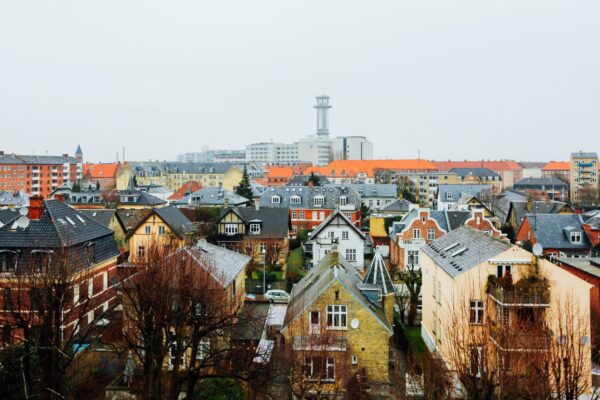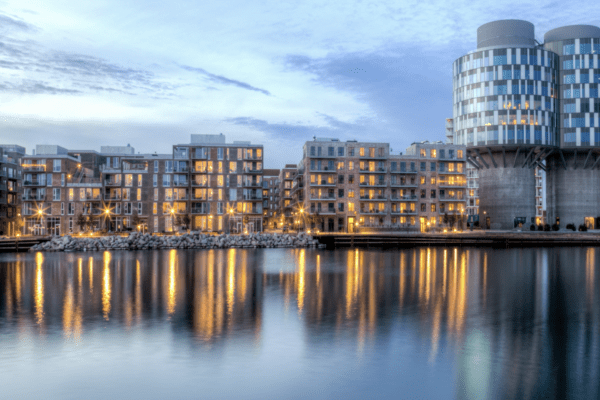Debatindlæg: The EU must regulate embodied carbon to deliver climate-proof buildings
The EU is neglecting emissions from building materials and construction, but the negotiations on the Energy Performance of Buildings Directive can fill this gap, writes a group of leading Danish professional associations and NGOs.
Debatindlæg bragt i Euractiv, den 15. marts 2022 af Thomas Damkjaer Petersen, formand i IDA, Claus Ekman, direktør i Rådet for Grøn Omstilling, Lene Espersen, direktør i Danske Arkitektvirksomheder og Henrik Garver, direktør i FRI.
At every phase of its existence, a building has an impact on our climate. Thus far, EU legislation has focused on reducing greenhouses gas emissions related to energy needed to heat, cool and power a building. Yet, a lot remains to be done to cut down emissions from the building materials and constructions, also known as embodied carbon.
Of the 36% of the EU’s greenhouse gas emissions the building sector is responsible for, 10-20% of these emissions derive from the production of building materials, construction, renovation and demolition processes.
As European buildings become more energy efficiency and are powered by renewables, emissions from embodied carbon will increasingly dominate. In Denmark, up to 75% of buildings’ CO2 emissions are embodied emissions.
Despite this development, most governments aren’t taking action to reduce embodied emissions. Only 5 EU countries – Sweden, Denmark, France, Finland and the Netherlands – have introduced regulation on whole-life carbon emissions, meaning addressing both operational and embodied emissions.
There is also no regulation across Europe to ensure the mitigation and measurement of the impact of construction and building materials happens in a coherent framework.
The good news is that EU building legislation currently under review could help fill this gap and finally tackle emissions generated through all the stages of a building’s life. As a bearing pillar of the EU’s Renovation Wave, the revised Energy Performance Building Directive (EPBD), which the European Commission proposed last December, is expected to set Europe’s building sector on the path to zero emissions by 2050.
The proposal introduces a wide range of important measures to cut energy waste in buildings and to move to cleaner heating solutions, such as the introduction of minimum energy performance standards.
Nevertheless, it has been disappointing to see that the European Commission’s proposal only requires EU member states to report on whole-life carbon for new buildings as of 2030 and completely fails to move forward on reducing embodied carbon.
With the negotiations in the European Parliament and Council starting soon, there are still opportunities to ensure the EPBD addresses also the climate impact of building materials and construction. Using reliable data and examples from EU-frontrunner countries, the EPBD can introduce an EU-wide whole-life carbon cap at least for new buildings.
This would set the building sector on a course for immediate CO2 cuts in the construction of new buildings across Europe, while we are awaiting sufficient data being gathered for establishing CO2 caps that will target the renovations.
Without regulation of embodied carbon, the EPBD will miss its goal of decarbonising the building stock and the EU will fail to achieve climate neutrality.
Measuring, disclosing and regulating embodied carbon will unlock major benefits for the economy and construction sector, too. Engineers, building owners and architects will be able to identify and choose low-carbon materials and products for their projects.
Manufacturers will be incentivised to produce low-carbon construction materials, creating a market for more sustainable products.
Industry groups, civil society, engineers and architects know that they way we design and construct buildings needs to change radically to avert the climate crisis – and the entire value-chain is ready to do it. Denmark and the other EU member states should ensure the negotiations on the EU Energy Performance of Building Directive answer this call.
Authors:
- Thomas Damkjaer Petersen is the chairman of the Danish Society of Engineers
- Claus Ekman is the CEO of Green Transition Denmark
- Lene Espersen is the CEO of the Danish Association of Architectural Firms
- Henrik Garver is the CEO of the Danish Association of Consulting Engineers






